ERIK TRUFFAZ / “Saisir”
When I listen to records like Erik Truffaz’ “Saisir” (a French verb meaning to grasp, seize or hold), I hear shapes instead of sounds, angles instead of notes. The keyboards are circles. The drums are squares, of course. The guitar is a series of undulating sine curves, like in trig class. Then comes Erik’s trumpet, full and hot: not a shape itself, but a negation of physical form. You recognize it by the way it marks whatever it contacts, leaving in its wake white-hot streaks of blank space, like echoes.
Recently*, I learned that there is a word for hearing shapes (or seeing sounds or feeling colors, etc.). The word is ‘synesthesia’: “a condition in which one type of stimulation evokes the sensation of another, as when the hearing of a sound provokes the visualization of a color.” In the case of music, the best way to experience this reversal of the senses is late at night while driving, preferably while driving fast. I can’t speak for other musical synesthetes, but I mostly hear shapes when listening to jazz…and usually trumpet players. Every once in a while, a good hip-hop instrumental does it too. Inevitably, vocals prohibit the effect. Don’t ask me why.
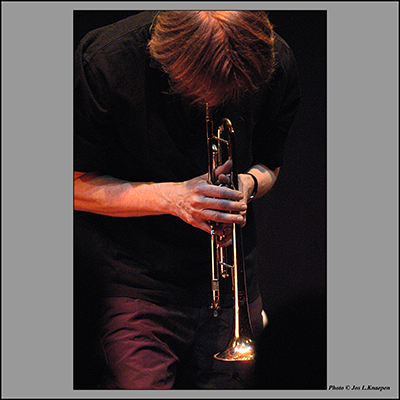
Back to “Saisir” from Mantis (Blue Note - 2002). The composition evolves. The shapes intensify, become increasingly well-defined. Right angles elbow past sweeping arcs. Long, lean lines stretch upwards and past wider, more compact ones. By the fifth minute, the shapes are no longer recognizable as individual forms. Squares torn apart, broken at the corners. Circles, collapsed into squiggles. Curves straightened. Straight lines bent. The climax of the record is accompanied by a naissant sensation as the shards of sound reassemble themselves into a single, brilliant mass.
More synesthetic sounds:
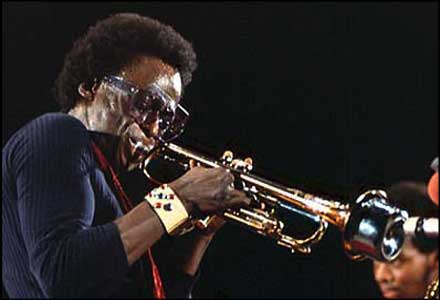
Miles Davis – “Dolores” from Miles Smiles (Columbia - 1966) (Towering cityscapes and sweeping turns. Fleet and sophisticated.)
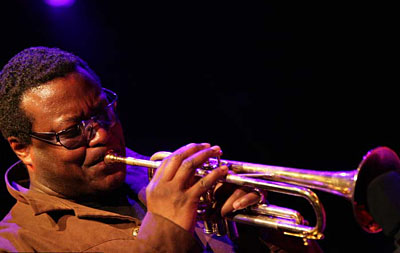
Wallace Roney – “G.D.D.” from The Wallace Roney Quintet (Warner Bros. - 1996) (Synesthesia in color: deeply-textured purple, dark-chocolate brown and a very, very sophisticated red.)
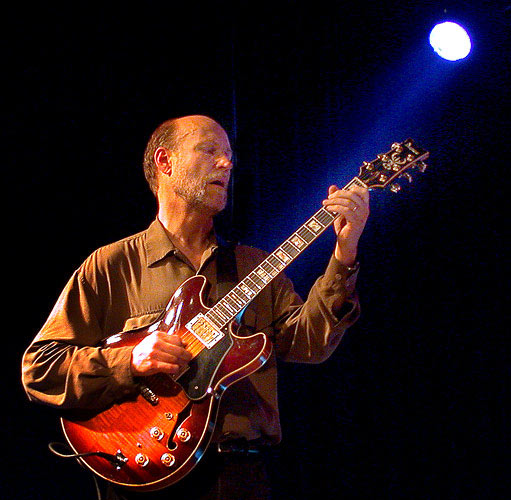
The John Scofield Band – “Philiopiety” from Up All Night (Verve - 2003) (Bouncing, silver orbs, ragged grid-like planes and squishy blobs of bass.)
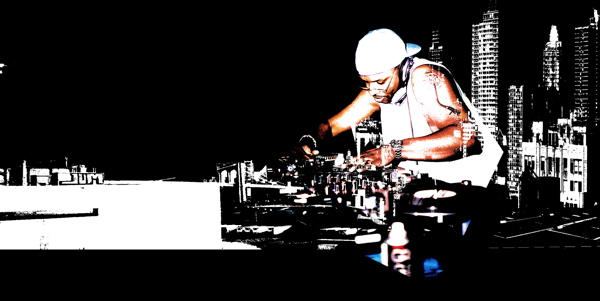
Nuyorican Soul feat. DJ Jazzy Jeff – “Jazzy Jeff’s Theme” from Nuyorican Soul (Giant Step/Blue Thumb - 1997) (Synesthesia hip-hop style: a single phrase shredded to beautiful bits. To the beat, of course.)
—Mtume ya Salaam
* One night last week while reading Alan Fletcher’s The Art of Looking Sideways. Page 138, specifically.
And now for something completely different
I don’t see, in fact, a lot of times when listening to really hip music live, I will close my eyes. Sight gets in the way of my enjoyment. My imagination is working but my imagination is not representational, i.e. I don’t “see” a particular thing. I hear sounds and those sounds help me think in different ways about the world. I no longer see anything in particular, I re-conceive what is and am free to imagine what could be, what I might bring into existence by transforming what exists or by creating unique combinations of pre-existing concepts. Like I remember when I came up with the phrase: emotional nudity, I was thinking on how certain musicians are able to share their innermost feelings and thoughts, and when I heard whomever it was I was hearing, I came up with a phrase to describe what I was hearing. That’s what music does for me, the sounds fertilize my imagination. Some sounds are particularly potent.
I remember once, I was recently married, no children yet. it was after midnight. I was sitting in the front room of our apartment. All the lights were out. I was listening to Coltrane’s Om. Tayari came into the room, really, really shook up. She turned the lights on and said that she was scared. She didn’t know what was going on.
What I like to do is take long drives with music. I mean like four or five hours and I play the music loud and I be in another world, fully aware of the road but gone into the way-out-a-sphere. I don’t be “seeing” nothing. I guess Mtume didn’t get synesthesia from me.
But, let me break something down. Whether Mtume knows it or not, he’s a Miles freak. All of the tracks he selected are Miles. Some obviously so (the Truffaz, the Roney, and of course Miles himself), but the others also. Truffaz and Roney are both trumpeters, both, sometimes accused of being Miles clones (Truffaz from electric Miles, Roney from classic acoustic Miles). While I think that’s a lazy approach to critiquing their music, I do agree they are mining territory first mapped out by Miles. John Scofield was a Miles Davis band alum. And Jazzy Jeff, probably has worn out a couple of Miles On The Corner Lps.
The biggest difference is that none of these cats have the quality bands that Miles had, thus no matter how much music the leader makes, the sidemen are seldom outplaying the leader and none of the bands are even half as tight and adventurous as many of Miles’ best units were.
I am not knocking these cats, because there are few bands in the history of jazz that can match Miles classic quintets or even certain editions of his electric bands—that’s just hard facts. Miles found Wayne Shorter after Trane, but who has been Shorter’s match? (I am not implying that Shorter was Coltrane’s match.) The closest Miles came to a major saxophonist post Shorter is Kenny Garrett, but then where is the Red Garland or Herbie Hancock on piano. Don’t even get me started on Paul Chambers or Ron Carter on bass, and Philly Jo “rimshot” Jones or Tony Williams on drums. I mean you got to climb Mount Olympus to match those giants, and all of them playing together in one band. You see that was Miles’ secret weapon: great bands.
So I am not putting the cats down to say they are in the Miles bag, I am just indicating what tree the fruit is dropping from. These cats often sound like Miles-lite mainly because by comparison their bands be lightweights, or welterweights, trying to slug it out for the heavyweight championship.
On another note, I drop some really different sounds into the mix and wonder what Mtume sees when he hears—if he can hear—Cecil Taylor. Now you want to talk about some other kinds of stuff, get to this: "After All NO. 2" from Silent Tongues (Black Lion - 1975)
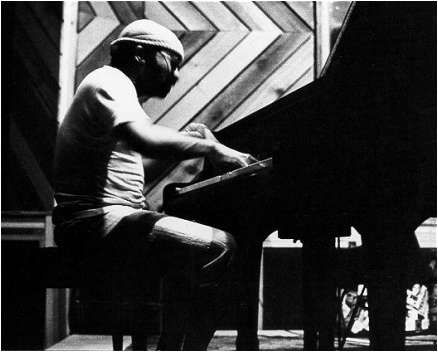
I’m a huge fan of solo Cecil Taylor. I once drove to Memphis or somewhere with about six or seven solo Cecil Taylor albums—no, it wasn’t Memphis, it was Oxford, Mississippi, about four hours from New Orleans.
The little sliver of a selection I have chosen is uncharacteristically short by Cecil standards, who averages 20 or 30 minutes a selection, and it is also uncharacteristically melodic. None the less, it is representative of a completely different approach to music, one that dumps the western system in favor of something shockingly different. Or, as one jazz writer put it, he sounds like 88 tuned drums beating furiously.
A major irony is that Taylor plays “out” (i.e. avant garde) music on the most “in” of instruments: the western-tuned piano, plus Cecil was trained in classical music at the New England Conservatory of Music. But he doesn’t sound like it. Mtume, I wonder what you see, when you hear Cecil Taylor.
—Kalamu ya Salaam
Fear, freaks, 88 drums, music....
1. Mama got scared listening to Om, because Om is scary music. The white kids at Tower used to listen to it when they wanted to freak themselves out completely and acid alone wasn't doing it for them. Isn't it true that freedom in its most advanced forms is virtually indistinguishable from anarchy? That's what's scary about Om—it sounds like musical anarchy. But, even through the din, you can tell these cats can play. They're raising that insane racket for a reason. If we assume/presume they're not either stoned or insane, we're left with the knowledge that there are things that motivate some sober, intelligent and talented individuals that we can't even begin to understand. Hence, the fear. (Om on blast. In the dark. After midnight. I'm surprised she wasn't dialing 911, like  )
)
2. I can confirm that Mtume knows he's a Miles freak—I just checked with him. I asked him, "Are you aware that you're a Miles freak?" He hesitated for a minute, then said, "Yes." He told me his favorite jazz album is Filles De Kilimanjaro. Of course, I told him that some people don't consider that kind of music jazz. Then he told me his second-favorite jazz album is Nefertiti. I said, "That can't be. Same artist. Virtually same band." He just smiled.
3. The Cecil Taylor record is beautiful. I'm not seeing shapes—then again, it's not dark and I'm not driving—but I like it.
4. There's a drop-in they play before certain movies (I think it might be for Digital Signal Processing or something) where they show a close-up shot of the inside of a piano: wooden mallets striking strings. It makes you realize the piano is (or may be or can be) a percussion instrument. 88 tuned drums. Music, man....
-Mtume ya Salaam
This entry was posted on Sunday, December 11th, 2005 at 1:19 am and is filed under Contemporary. You can follow any responses to this entry through the RSS 2.0 feed. You can leave a response, or trackback from your own site.
2 Responses to “ERIK TRUFFAZ / “Saisir””
December 15th, 2005 at 4:19 am
Just a shout out for my man Bill Evans (R.I.P.).
But yeah, Miles assembled some great bands. Who could find a band that could go modal for damn near 20 minutes and still be enthralling from beginning to end (i.e. In a Silent Way LP)?
December 15th, 2005 at 4:22 am
Just listened to the Cecil Taylor. I’m really interested to hear what he would sound like in an ensemble setting.
Leave a Reply
| top |